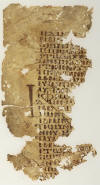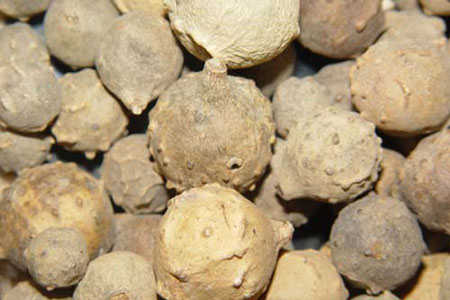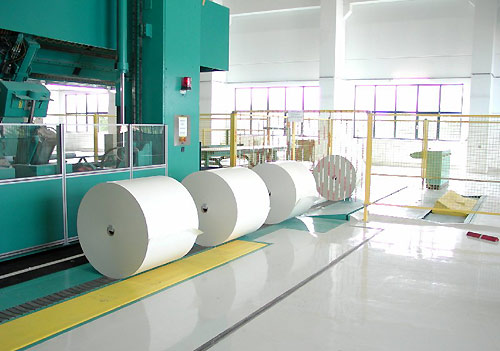Paper
For centuries, people tried to discover better surfaces on which to record their thoughts. Almost everything imaginable was tried. Wood, stone, ceramics, cloth, bark, metal, silk, bamboo, and tree leaves were all used as a writing surface at one time or another.
The word "paper" is derived from the word "papyrus," which was a plant found in Egypt along the lower Nile River.
Paper is made of pulped cellulose fibres (usually cotton, flax, or wood), whereas papyrus is made of sliced sections of the inner pithy body of the flower stem of the papyrus plant, laid in two layers at right angles, pressed together and dried. A major drawback to papyrus was that ink would not penetrate the surface.
In the second century BC, the Greeks were using parchment made from goat or sheep- skin. The skins were wetted, stretched on a frame and repeatedly scraped. This was a labor- intensive process that did not produce many sheets of writing material, quickly.
 Coptic manuscript on vellum 10th Century AD
Coptic manuscript on vellum 10th Century AD
_lg_small.jpg) parchment leaf from a small codex 5th Century AD
parchment leaf from a small codex 5th Century AD
The Torah (scroll) must be written on gevil of klaf..... only hides of kosher animals are permitted.
The most preferable quality parchment is Shlil, the hide of the embryo or a newborn calf. The surface of the Klaf should not be coated or glazed. Approximately sixty-two hides are needed for a complete Torah. The average size of a newly written Torah is between 17 to 20 inches
INK
http://www.ctc-torah.org/2009/07/the-ingredients-part-iii-dyo-ink/
The one overriding halacha of the dyo (sofer’s ink) is that it must be absolutely black, through and through. No other color can be mixed in, nor can it have any composite colors. Black – pure and simple.
Although there are several ink recipes, everyone today makes ink from three basic ingredients:
The most curious ingredient of the lot is Gall Nut juice. “What is a gall nut?” you may ask…

http://en.wikipedia.org/wiki/Oak_marble_gall
Some species of wasps (the Marble wasp, for example) lay their eggs in oak tree branches and twigs. When the tree identifies a possible parasite has having moved in, it quickly grows a large knot, a “gall nut,” around the foreign body to isolate it from doing more damage.
Gall nuts are important because they are rich in tannic acid The pure black tint of the ink results from the reaction between the tannic acid and iron sulfate.
There are a LOT of ink recipes out there. This is the most basic one and is from the sefer Chasdei Dovid:
Crush the galls as finely as possible.
Mix all the ingredients together into a sturdy pot.
Cook the mixture for a long time on low to medium heat until you have only a gloopy sort of residue left.
Strain out all the solid material using a fine mesh.
Pour the strained residue into a clear glass bottle and seal it tightly. Let it sit for about 6 months until it turns jet black.
If a Sofer doesn’t have 6 months to wait, the alternative is to buy ready-made ink.
http://merkazhasofrim.com/index.php?route=product/product&path=59_60&product_id=100
We see the real explosion of writing when the Chinese, in the second century BC, invent a paper from pounded Mulberry bark and bamboo. This produced thin sheets that could be produced quickly and that ink penetrated. Because of the latter property, ink could not be erased from this paper.
http://www.hollanders.com/papers/BrowseCategory.aspx?CategoryID=fa1ccc5d-c484-49e2-adf0-0620475ee3ba
For approximately 500 years the art of papermaking was confined to China, but in 610 it was introduced into Japan, and into Central Asia about 750.
In 793, there was a factory working in Baghdad. Paper made its appearance in Egypt about 800 but was not manufactured there until 900, and from there the knowledge was taken to Morocco, and from Morocco to Europe by the Moors.
Early paper was at first disfavored by the Christian world as a manifestation of Moslem culture, and a 1221 decree from Holy Roman Emperor Frederick II declared all official documents to be written on paper invalid.
With the invention of the printing press in 1448 by Johannes Gutenberg, there was an explosion in the use of paper.
Rag Paper
The most commonly used fibre, or rag, is cotton. Because the length of fabric fibres is longer than that of wood, rag-based papers are stronger and tend to take more 'wear', such as scrubbing with a brush.
Rag-based papers are also more archival in quality; cotton, for instance, is naturally PH-neutral.
People know what money feels like. People who handle money constantly, like bank tellers, cashiers and wait staff, can feel a counterfeit bill instantly if the paper is wrong.
That "feel of money" comes from at least three different things that make the paper in paper bills unique:
One big advantage of using rag paper is the fact that it does not disintegrate if you accidentally run it through a washing machine.
http://www.crane.com/navContentProduct.aspx?NavName=AboutUs&DeptName=CurrencyPaper
http://www.moneyfactorystore.gov/
All Early paper was made of rags, and rags were hard to come by.
Ironically, when the Plague killed millions of people in Europe, tons of clothing and rags became available at just about the time the printing press was invented.
Technical progress and an upsurge in papermaking continued in the 17th Century and soon led to a shortage of raw materials and to regulations governing the trade in rags.
Rene de Réaumur who, in the 1700s, watched a species of wasp we now call the paper wasp. These insects were munching on wood. Not eating it, exactly, but chewing it up, spitting the mush back out and forming nests with it.
It seemed to him that the wasps were making paper out of wood.
By the 1860's rag pulp paper was replaced with wood pulp due to the introduction of wood grinders.
Bond paper is a strong, durable paper especially suitable to office machines including copiers and desktop printers.
Bond paper has a basic size of 17" x 22" and a basic weight of 13 to 24 lbs. It is characterized by erasability, good absorption, and rigidity.
Bristol board
Bristol paper is a heavyweight paper with a bulk thickness of .006" or higher. Bristol paper may be made by layering or laminating papers together to the desired thickness. The basic size is 22.5" x 28.5".
The name comes because this type of paper, originally made from rags, came from Bristol, England.
Bristol paper is used for paperback book or catalog covers, file folders, tags, and tickets. Engravers or Wedding bristol paper may be used for formal engraved wedding invitations.
Parchment or Vellom
Once made from animal skins, the parchment paper look is now achieved by treating paper from cellulose fibers with sulfuric acid. Parchment paper is characterized by a hard surface, high wet-strength, resistance to grease and dirt. Some imitation parchment paper has the mottled parchment look printed onto the paper.
May be used for certificates and diplomas or anytime an "old-fashioned" look is desired.
Bible
Bible paper is a thin, lightweight, opaque printing paper. Generally made from 25% cotton and linen rags or flax in combination with chemical wood pulp, bible paper typically has a long life.
Typical uses for Bible paper, in addition to Bibles: dictionaries, encyclopedias, insurance rate books or other deluxe guides, and multi-fold package inserts.
Book
Book paper is a general term to describe a type of paper suitable for printing, (except newsprint and bristol), especially offset printing.
Book paper can have many different finishes and may be coated or uncoated.
More opaque than Bond paper and good for 2-sided printing, book paper is also characterized by excellent folding qualities and durability.
Book paper has a basic size of 25" x 38" and the basis weights range from 22 to 150 lbs.
Newsprint
Inexpensive paper made primarily of mechanically ground wood pulp rather than chemical pulp is known as newsprint. Has a shorter lifespan than other papers but is cheap to produce in bulk and is the least expensive paper that can withstand normal printing processes.
Typically used for newspapers and may also still be used for comic books, some newsletters and trade magazines and buy/sell/trade classified ad weeklies.
Inkjet Paper

Cheap papers are suitable for normal printing for pictures to share with friends and family, and also have their use for proofing pictures you intend to print for sale or display on more expensive materials.
How see-through is the paper? The higher the opacity, the less that printed text and images will bleed through to the other side. This is especially important for double-sided printing. Inkjet photo papers have a relatively high opacity (94-97 usually) compared to ordinary inkjet or laser papers so bleed-through is less of a problem with these papers.
The brightness of a paper is normally determined by how rough the
surface of the paper is. A course or rough paper will scatter light in several
directions, whereas a smooth paper will reflect more of the light back in the
same direction. This makes the paper appear brighter, which in turn makes any
image on the paper appear brighter. You can see this yourself by comparing a
photo in a newspaper with a photo in a magazine. The smooth paper of the
magazine page reflects light back to your eye much better than the rough texture
of the newspaper. Any paper that is listed as being bright is generally a
smoother-than-normal paper.
UNTITLED, 2003
Block of fir, ream of paper 2 x 8.5 x 11 inches
Paper weight may be
expressed in pounds (lb.) or as grams per square meter (g/m2). Different types
of paper have their own weight scale. The bond papers which include most inkjet
photo papers are found in the 24 to 71 lb. (90 to 270 g/m2) range.
or
500 sheets of bond paper with a size of 17" by 22" have a weight of 20 pounds.
The manufacturer would cut a sheet that big into four letter-size sheets, so a 500-sheet ream of 20-pound bond paper weighs 5 pounds.

Photo papers are heavier and thicker than typical multi-purpose papers. This thickness, known as caliper, is necessary to accommodate the greater ink coverage typically found in photos. Typical inkjet paper caliper may be anywhere from a thin 4.3 mil to a thick 10.4 mil paper. Photo paper is usually 7 to 10 mils.
Another key factor in image quality is absorption. When the ink is sprayed onto the paper, it should stay in a tight, symmetrical dot. The ink should not be absorbed too much into the paper. If that happens, the dot will begin to feather. This means that it will spread out in an irregular fashion to cover a slightly larger area than the printer expects it to. The result is an page that looks somewhat fuzzy, particularly at the edges of objects and text.

Imagine that the dot on the left is on coated paper and the
dot on the right is on low-grade copier paper. Notice how irregular and larger
the right dot is compared to the left one.
As stated, feathering is caused by the paper absorbing the ink. To combat this, high-quality inkjet paper is coated with a waxy film that keeps the ink on the surface of the paper. Coated paper normally yields a dramatically better print than other paper. The low absorption of coated paper is key to the high resolution capabilities of many of today's inkjet printers. For example, a typical Epson inkjet printer can print at a resolution of up to 720x720 dpi on standard paper. With coated paper, the resolution increases to 1440x720 dpi. The reason is that the printer can actually shift the paper slightly and add a second row of dots for every normal row, knowing that the image will not feather and cause the dots to blur together.
The coating on photo papers give your printed photos the look and feel of photographic prints. Because the coating keeps the paper from readily absorbing the ink some glossy papers dry slowly. However, quick-dry gloss finishes are common today. The finish may be described as high gloss, gloss, soft gloss, or semi-gloss, each reflecting the amount of shine. Satin is a less shiny coated finish.
Gloss papers are generally made for non-archival use. They range from highly reflective plastic films to materials with a relatively low gloss, that are almost closer to a pearl or luster finish.
Pigment printers seldom produce good results on gloss surfaces, often giving very slow drying and patchy results.
Images printed on photo matte papers appear soft and non-reflective, not shiny. Matte finish papers are not the same as regular inkjet finish papers. Matte finish photo papers are thicker and are specially formulated for photos. Many matte finish papers are printable on both sides.
Matte papers are suitable for both pigment and dye based inks. For those printing in black and white in particular, matte surfaces give less brilliant prints than glossy, with lower maximum densities. However, visually the lack of surface reflections can make the blacks look good, and once framed under glass, the differences between prints on glossy and matte are quite hard to distinguish.
Matte papers differ greatly in their surface texture and color, from optically brightened intense cool whites through warm whites to those that might be called cream or even pale yellow. Some papers are extremely flat, while others have quite intrusive textures that can overwhelm detail in images and are only suitable for large prints depending on broad effects.
Fine Art Papers - Archival qualities
Three factors - paper, ink and paper coating - interact to determine print lifetimes, as well as the environmental factors including storage and display conditions. Good papers are likely to lead to longer lifetimes, and as with most other media, this generally means acid-free materials.
The best papers are generally made from 100% cotton rag rather than wood pulp, and these tend to be expensive - at least a dollar for an A4 sheet and often rather more.
The fine art papers share two main qualities - they are expensive and have a matte surface.
Although nominally all white, some might more accurately be called pale yellow. All are acid-free, most are 100% cotton.
With all fine art papers ensure that the surface is clean and dust-free immediately before printing by brushing gently with a soft 2" brush kept for this purpose, then using a blast of air. As well as removing anything loose on the paper surface that will drop off after printing to leave a white spot in the print, this also helps to prevent a build up of fine dust that can clog printer heads and mechanism.
All printing paper needs careful handling, and fine art materials even more so. Avoid touching in the printing surface, and load ways load the paper before you print, rather than relying on auto loading.
Since all fine art papers have a non-glossy surface, there are seldom if ever any problems with the 'pizza wheel' effect where the paper feed wheels on some printers can make marks on prints.
Many companies that sell inkjet paper provide sample packs containing a few sheets of the different papers they stock at reasonable prices, and it is worth getting these to decide which paper you prefer to use.
http://www.inkjetart.com/cart/media-papers-c-1_6.html
Transformation Card Paper
Two essential elements that make a playing card a
playing card are the paper and varnish.
A. Paper is usually 2 or 3 ply playing card stock often called "black liner
board". Most stock is from mills in Germany and France. It is laminated
with a black graphite glue which guarantees opacity.
B. The "playing card varnish" is a custom formula; most major card
makers have their own. The varnish helps determine the "slip" and feel
of the cards, how they slide against each other, and protects the cards from
grease and dirt. If you are making hand-made cards, you should give some
consideration to finishing the cards and making them easy to handle. Card
magician Kevin Gallagher says "To me, the design is secondary to how
well they handle since they are going to get written on, torn up and generally
abused anyway".
With hand-made cards, one can experiment finishing the cards by lightly
polishing with wax, soap or fixative spray to make them slippery.
http://www.wopc.co.uk/otc/production.html
http://www.usplayingcard.com/pages/custom_cards/10.php
http://www.customplayingcards.co/faq.php
http://weevilgenius.net/2010/04/making-your-own-playing-cards/
http://koehlerpaper.com/en/papier/fine-tech/spielkartenkarton/casino-imperial.php
Non-Coated Water Color Art Papers
Coated Water Color / Art Papers
http://www.westcoastimaging.com/
http://www.adoramapix.com/app/products/prints
http://www.snapfish.com/snapfish/photo-prints